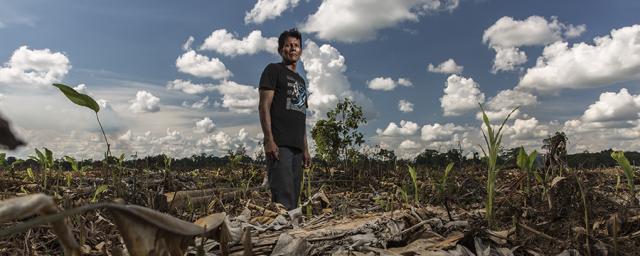
The indigenous Shipibo community of Santa Clara de Uchunya, in the Peruvian Amazon, is facing invasion of its ancestral lands by corporate oil palm plantations and land traffickers. 7,000 hectares of forest have been destroyed. Photo : Diego Pérez/Oxfam
“Communities around the world rely on their customary lands to feed their families. But their lands also feed the world.”
Up to 2.5 billion women and men worldwide depend on indigenous and community lands to survive. These lands, which are held, used or managed collectively, cover more than 50% of the world’s surface.
Yet, Indigenous Peoples and local communities who have protected these lands for centuries, legally own just one-fifth.
This gap represents at least 5 billion hectares of unprotected lands vulnerable to land grabs by governments and corporations. In Africa, 90% of rural lands are not documented.
How securing collective land rights benefits the whole planet
There is growing evidence of how vital the role played by full legal ownership of land by Indigenous Peoples and local communities is in preserving cultural diversity and in combating poverty and hunger. The failure to recognize community land rights not only undermines the human rights of local people. It also threatens humanity’s ability to achieve food security and fight climate change.
70% of the world’s food is produced by small-scale producers, many of whom rely on natural resources that are held in common. Securing land rights help communities to manage their land more sustainably, to access credit, diversify activities and invest. It can boost farmers’ productivity by 60 percent and more than double family income. This is a key strategy to increase global food production as the population continues to grow.
The collective natural resources governed by Indigenous Peoples and local communities are biodiversity hotspots that maintain the ecological balance of our planet and help regulate the climate that enables global food production. Research shows that their lands store massive amounts of carbon – at least 300 billion megatons – and that secure rights lead to lower rates of deforestation.
Women’s land rights are particularly important given their crucial role in ensuring local food security and managing community resources. The FAO estimates that if we close the gender gap in agriculture, production could increase by 20-30%. Research shows that women’s land rights are also associated with better health and nutrition outcomes.
Small-scale food producers not only produce most of the world’s food, but they also protect and sustain diverse food cultures and landscapes. Secure land rights are foundational to preserving diverse local food systems where consumption is less commodified, and traditional knowledge and practices around food are valued. Indigenous Peoples and local communities preserve 80% of the world’s biodiversity.
Janeth Pareja Ortiz, from Ipuana community, in Colombia, is a defender of human, territorial and environmental rights.
She lived near the Aguas Blancas stream, which was her main source of livelihood until a mining company began to pour toxic wastes. Shortly after, the company decided to divert the stream until it dried up.
Janeth denounced the company's practices to the authorities but instead she began receiving death threats until she had to flee.
Today she still is a defender of human, territorial and environmental rights and visits the communities in the area protected by armed bodyguards. She is part of "Fuerza de Mujeres Wayuu", an organization that advocates for environmental and land rights.
Photo: Pablo Tosco/Oxfam
Join us and be part of a powerful movement
Around the world, a powerful movement to secure land rights is growing. From Myanmar to Guatemala, from Australia to Uganda, Indigenous Peoples and local communities are mobilizing to call for the recognition of their rights.
We can support them and their courageous struggles. As part of the global Land Rights Now movement, we are calling on governments and corporations to end land grabs immediately and respect land rights as a way to ensure long-term food security and preserve biodiversity and culture.

Land Rights Now is an international alliance campaign that aims to secure indigenous and community land rights worldwide. Since its launch in March 2016, it has been joined by over 800 organizations and thousands of individuals from all corners of the world. Its target is to double the global area of land legally recognized as owned by Indigenous Peoples and local communities by 2020.

